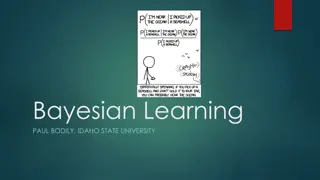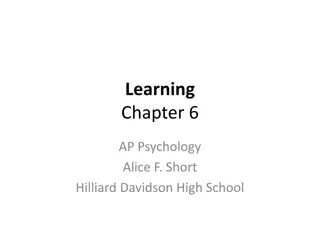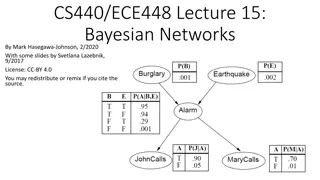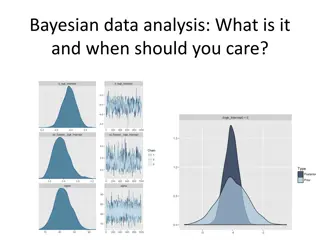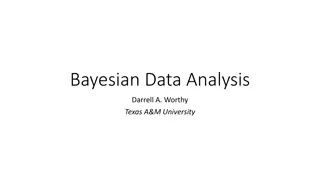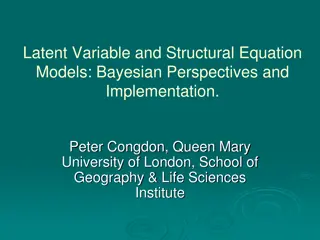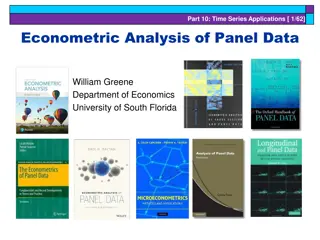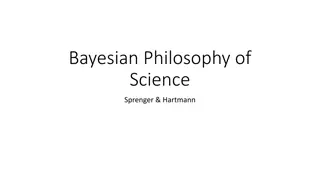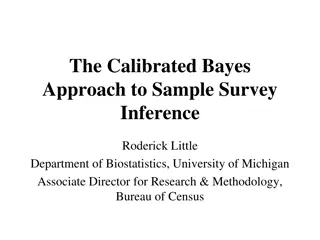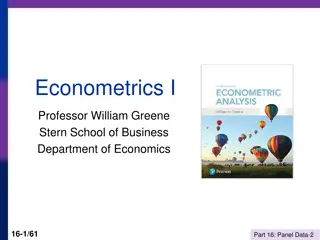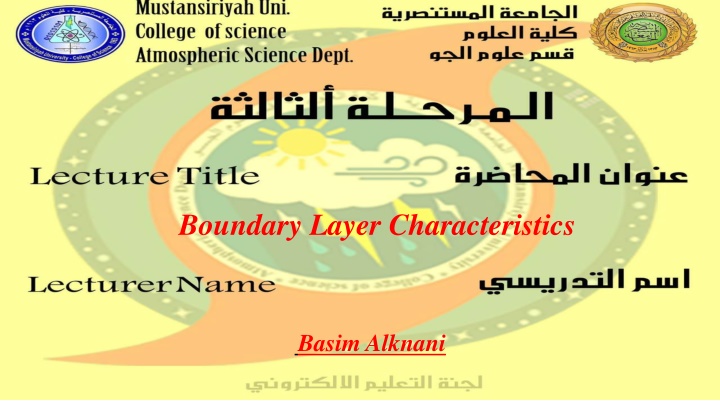
Bayesian vs. Classical Econometric Analysis of Panel Data by William Greene
This study delves into the contrast between Bayesian and Classical estimation methods in the analysis of panel data by William Greene, exploring mixed logit models, random parameters modeling, and extensions of classical models. The study also discusses the relationship between mixed logit and Bayesian treatments, applying these techniques to real and simulated datasets related to choice modeling. Various aspects of discrete choice models, model building developments, and individual heterogeneity are examined and compared between Bayesian and Classical approaches.
Download Presentation

Please find below an Image/Link to download the presentation.
The content on the website is provided AS IS for your information and personal use only. It may not be sold, licensed, or shared on other websites without obtaining consent from the author. If you encounter any issues during the download, it is possible that the publisher has removed the file from their server.
You are allowed to download the files provided on this website for personal or commercial use, subject to the condition that they are used lawfully. All files are the property of their respective owners.
The content on the website is provided AS IS for your information and personal use only. It may not be sold, licensed, or shared on other websites without obtaining consent from the author.
E N D
Presentation Transcript
Boundary Layer Characteristics Basim Alknani
Boundary Layer Characteristics The earth's surface is a boundary on the domain of the atmosphere. Transport processes at this boundary modify the lowest 100 to 3000 m of the atmosphere, and this is called the boundary layer . The remaining air in the troposphere is called the free atmosphere. The troposphere extends from the ground up to an average altitude of 11 km, Define the boundary layer as that part of the troposphere that is directly influenced by the presence of the earth's surface and responds to surface forcing with a timescale of about an hour or less. These forces include frictional drag, evaporation and transpiration, heat transfer, pollutant emission, and terrain. The boundary layer thickness is quite variable in time and space. Its maximum height can reach 3 km over deserts, dry fields and boreal forests. Over wetter surfaces the PBL reaches about 1 to 2 km. Two types of clouds are often included in boundary-layer studies. One is the fair-weather cumulus cloud and the other type is the stratocumulus cloud.
Characteristics of ABL The boundary layer ,dynamically distinct sublayers i) Interfacial sublayer - in which molecular viscosity/diffusivity dominates vertical fluxes ii) Inertial layer - turbulent fluid motions dominate the vertical fluxes, but the dominant scales of motion are still much less than the boundary layer depth. This is the layer in which most surface wind measurements are made. Layers (i) + (ii) comprise the surface layer. iii) Outer layer - turbulent fluid motions ( large eddies ). At the top of the outer layer, the BL is often capped by an entrainment zone in which turbulent BL eddies are entraining non-turbulent free-atmospheric air. This entrainment zone is often associated with a stable layer or inversion.
For example, the variations temperature in the lower troposphere are shown in Fig 1.2. These time-histories were constructed from radiosonde soundings made every several hours near Lawton, Oklahoma. It shows a diurnal variation in temperature near the ground this is not evident at greater altitudes. This diurnal variation is one of the main characteristics of the boundary layer over land. The free atmosphere shows little diurnal variation. This diurnal variation is not caused by the direct forcing of solar radiation on the boundary layer. Little solar radiation is absorbed in the boundary layer; most are transmitted to the ground where typical absorptivities on the order of 90% result in the absorption of much of the solar energy. It is the ground that warms and cools in response to the radiation, which in turn forces changes in the boundary layer via transport processes. Turbulence is one of the important transport processes and is sometimes also used to define the boundary layer.
Applications and Relevance of BLM The boundary layer is the part of the atmosphere in which we live and carry out most human activities. Furthermore, almost all exchange of heat, moisture, momentum, aerosols, gasses, and pollutants occurs through the BL Specific applications i) Climate simulation and NWP - parameterization of surface characteristics, air-surface exchange, BL thermodynamics fluxes and friction, and cloud. No climate model can succeed without some consideration of the boundary layer. In NWP models, a good boundary layer is critical to the proper prediction of the diurnal cycle, low-level winds, and convergence, of effects of complex terrain, and of timing and location of convection. ii) Air Pollution and Urban Meteorology - Pollutant dispersal, the interaction of BL with mesoscale circulations. Urban heat island effects. . iii) Agricultural meteorology - Prediction of frost, dew, evapotranspiration, soil temperature. iv) Aviation - Prediction of fog formation and dissipation, dangerous wind-shear conditions. v) Remote Sensing - Satellite-based measurements of surface winds, temperature, etc. vi) Military electromagnetic wave transmission, visibility.
Wind and Flow Air flow, or wind. It can be divided into three broad categories: mean wind, turbulence, and waves (Fig 1.3). Each can exist separately or in the presence of any of the others. Each can exist in the boundary layer, where transport of quantities such as moisture, heat, momentum and pollutants. The transport process is horizontal by the mean wind, and vertical by turbulence. Mean wind mean wind is responsible for very rapid horizontal transport, or advection. Friction causes the mean wind speed to be slowest near the ground. Vertical mean wind is much smaller, usually on the order of millimeters to centimeters per second. Waves, Frequently observed waves in the boundary layer at nighttime, transport little heat, humidity and pollutants. These waves can be generated locally by mean-wind shears and by mean flow over obstacles. Thus, the wave phenomena can be associated with the turbulent transport of heat and pollutants, although waves without turbulence would not be as effective. Turbulence The occurrence of high-frequency turbulence near the ground is one of the characteristics that makes the boundary layer different from the rest of the atmosphere. Outside the boundary layer, turbulence is found primarily in convective clouds, and near the jet stream where strong wind shears can create clear air turbulence (CAT). The frequent lack of turbulence above the boundary layer means that the free atmosphere cannot respond to surface changes.

